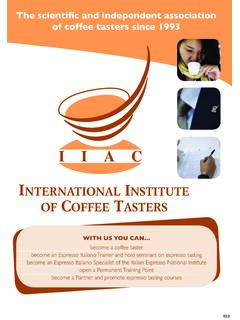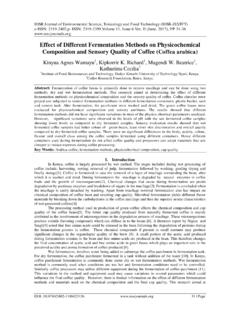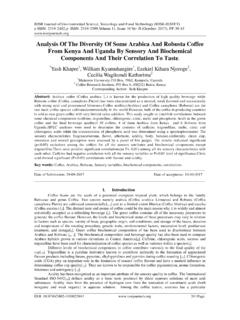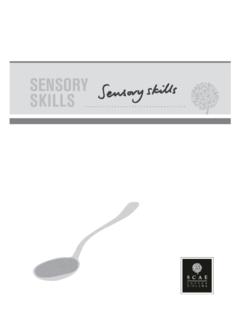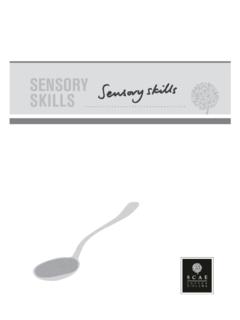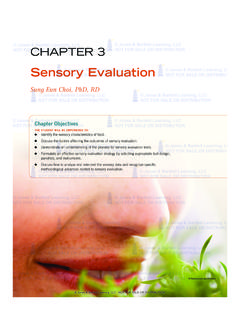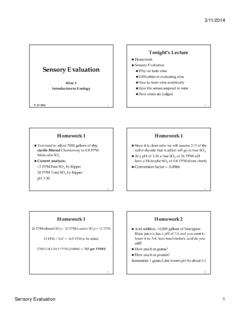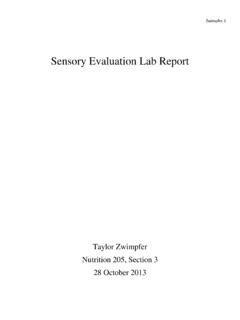Transcription of Sensory Evaluation of Coffee:-Cuptesting
1 Sensory Evaluation of Coffee:-Cuptesting What is Sensory Evaluation ? It is the conscious effort to identify and judge different sensations and components in an object, be it a piece of food, a beverage, or a perfume. Sensory Evaluation encompasses all of the senses. It takes into account several different disciplines but emphasizes the individual's perception. It involves the measurement and Evaluation of Sensory properties of food and other materials. Human judges are used to measure the flavor or Sensory characteristics of food. In short, Sensory Evaluation is a very organized holistic approach to product assessment. Uses of Sensory Evaluation Food companies and retail store owners need to evaluate and measure the taste, odor, texture, etc. of foods. A versatile instrument for this is the human Sensory system. In the food industry, Sensory Evaluation is used for: Grading: Foods can be graded and standardized; this is often done completely by a Sensory judgment.
2 This is a familiar practice in the wine industry where the expert taster designate wines. In the coffee industry we utilize expert cuppers. Quality Assurance: We need to understand variations in natural products but do not tolerate them in processed foods. Sensory Evaluation is a critical tool for Quality Assurance personnel. It can be used to test for off-flavors, changes due to reformulation, the effects of changes in processing, the effects of storage under various conditions (shelf life studies), the effects of packaging, etc. In coffee , we need to understand the scope of natural variation in our product. We use it to discern natural variance in new crop vs. past crop coffee or to distinguish new crop acidity from possible taint. Cup-testing/ Sensory Evaluation of coffee Cup-testing is the process of evaluating the aroma and taste characteristics of a sample of coffee .
3 It is the final phase of the quality assessment and quality assurance of a batch of coffee . It is the proof of the pudding phase. The process involves a standardized series of steps that prescribe the handling and preparation of the sample and the methodology to complete the Sensory Evaluation of a sample from the batch of coffee . Sensory Evaluation includes the following basic coffee characteristics. a) Fragrance b) Aroma c) Taste d) Nose e) Aftertaste f) Body g) Acidity During the cupping exercise a sample(s) is (are) evaluated in order to make a decision to purchase or sell the coffee . During the exercise a visual inspection of the beans is done in both green and roasted forms. The appearance of both the green and the roasted beans can give fair indication of the cup quality. Why do we cup coffee ? Everyone involved in the sale/marketing and purchasing of coffee should be able to cup- test the product since the taste of your coffee is one of the key factors in the success of your business.
4 Cupping ensures that the coffees match your specifications. Although it is not possible to taste all of the green coffee you receive, control can be exercised through the use of appropriate sampling techniques and through the system of green coffee specifications that describe the exact attributes of each coffee bought. Specific reasons for cupping 1. Comparative analysis of samples - When the cupping is done a comparative analysis done since a minimum of two cups is tested per sample. However, triangulation ( three or more cups), is best for comparison and provide sufficient contrast to properly judge the differences. Comparative analysis is helpful in both the selection of coffees for purchase and in cup-test training exercises. 2. Competitive analysis of samples - Most conscientious coffee roasters is usually concerned about the quality of their competitors' products.
5 Comparative blind taste sessions, frequently scheduled, will provide an invaluable base of information about the competitors' products and your product and their preference (if any) in the marketplace. 3. Taste education and knowledge building - The coffee taste knowledge for any individual will only improve with frequent cupping of different types of coffee . Repeated taste tests of the same coffees will build the memory for that particular group of coffee and their taste characteristics. When should we cup coffees? There is no best' time to cup coffees as this will vary with different individuals. coffee cupping is a physical act that requires concentration. It is also Sensory and cerebral an art form! Despite popular view about early morning cupping the time most convenient for this exercise will be applicable, as long the surrounding is relaxing, quiet and free from distractions.
6 Requirements for Cupping The coffee tasting process has evolved over a period of many years and has traditional tools, utensils and accessories, some of which are itemized below: - Sample Roaster Comprised of a rotating cylinder which is solid or perforated and use an adjustable direct heat source (electric or gas) which is adjustable. Some sample roasters are designed with temperature gauges whiles most are not. The roaster should be capable of producing a roasted product with even roast and results should be repeatable at a particular setting. coffee Tray - Various sizes and different shaped trays are used for the cupping exercise and the grading of green beans. The tray is traditionally made of tinned metal, but now it is available in cardboard and plastic. Grinder - A plate or mill-type grinder is desirable. It should be capable of producing a grind that will be fine enough to be used by a percolator.
7 Water Boiler A good kettle to heat the water to at least 205 F will suffice. The water must be as pure as possible and free from colour, taste and odour. Ideally, the water to be used should contain 100 to 2000 ppm of dissolved minerals (spring water is a good alternative). Never use soft or distilled water Tasting Table - A single pedestal table is required with a rotating top that can swivel the samples to various tasters seated around it. Additional features are a rotating arm, which holds a hot water bowl for rinsing the spoons and a simple balance scale mounted in the centre to facilitate the weighing of samples. Tasting Spoon The taster needs a good sterling silver spoon with a deep and wide bowl to accommodate a generous sample of the brew. Your tasting spoon should not be used for eating soup, etc.; tasting spoons must be kept pure.
8 Tasting Cups - Simple, inexpensive, highly glazed china soup cups or pudding cups are adequate. The cups must be able to accommodate 5 ozs of water and the head or foam that forms when hot water is poured onto the coffee . Spittoon - The spittoon is a container with a metal funnel mounted on a receiving chamber which receives the brew when it is expectorated. It is mounted on wheels to facilitate sharing among the cup test panelists. Any convenient vessel may be selected as a spittoon. When preparing coffee for cupping the following factors must be taken into consideration: Surrounding - It is mandatory to have peace and quite. The tasting area or room should be free of the following: a) noise b) dirt c) odours d) aromas other than coffee The whole atmosphere should be calm and it should allow the panelists to focus on the task at hand.
9 Sample - Samples should be properly identified and placed in coffee trays. If the test is to be blind, the identifications must be coded and the list that explains the coding must be secured. Rating Sheets - The various specifications for each is checked and the cup-test report form used to rate the products. Specifications/Standards - Your Company's green and roasted specifications/standards should be available. Written standards and specifications for your coffee will assist in your Evaluation process and provide a base or standard by which to judge. Steps to Cupping Use small tags, either mounted on the tray or tape underneath for blind tests. Carefully roast all samples to a light medium shade with a light sheen (not shiny or oily). Coffees should be roasted past the first popping but not to the second. The light medium roast will allow all the flavours and aromas to develop but will not mask any off-tastes'.
10 Place grams of roasted coffee form each sample in each cup and grind the content separately. This maintains the integrity of the sample in each cup. Use about 3 cups for each sample being tested. Grind each sample of coffee separately to a grind fitting for the percolator. Observe the fragrance of each cup of grounds before pouring the boiling water. When water has come to a boil, carefully pour the water into each cup. Be sure to wet all of the grounds. The coffee will form a head or foam at the top of the cup. Allow it to sit until all cups are poured then begin to break the head or foam and smell the aroma. Breaking involves placing the spoon into the cup below the crust and stirring vigorously while your nose is directly above the cup. Inhale the aroma rising from the grounds, rinse your spoon and move to the next cup.
